Aquarium Shark Fish & Algae Eaters
Aquarium Shark Fish get their name because they look like minature ocean sharks. The most popular aquarium shark fish are the Red Tailed Black Shark and the Rainbow Shark. The Bala Shark and the Iridescent Shark look even more like saltwater ocean sharks, but they often grow too big for most aquariums. The Flying Fox and Algae Eaters also look like sharks. Don't expect algae eaters to solve an algae problem in your tank though. They only remove a small amount of algae. The Siamese Algae Eater is popular. Below you will also find profiles on the Chinese Algae Eater and the Chinese Hi Fin.
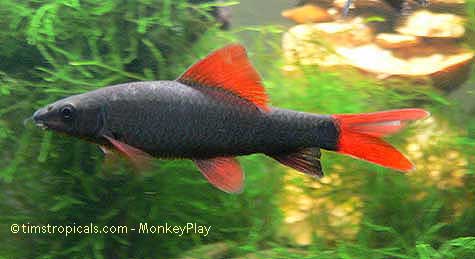
Rainbow Shark
The Rainbow Shark originally came from Thailand and Indonesia. It is an algae
eating minnow. The body has a greenish hue and the fins are red or orange.
They are also know as red finned sharks. They are aggressive and intolerant of their own
kind unless they are in groups of at least six. Normally it is best to
keep no more than one. Rainbow Sharks like a sandy substrate and spend
most of their time in the lower levels of the tank, but make sure the tank is
covered, as they are jumpers. They like caves and are very territorial, so
provide lots of both space and aquarium decoration. They eat flake foods,
vegetable matter, bloodworms and tubifex worms. Plant matter will enhance
their color. Breeding is very difficult.
Comments from Saduct:
Rainbow sharks are fine with loaches I have three of each in my tank and
they do not interact at all. It's like they don't even know each other is there.
Rainbow Shark Profile
-
Scientific Name: Epalzeorhynchos frenatum
-
Family: Cyprinid
-
Temperature: 24 - 28 C; 68 - 78 F
-
pH: 6.0 - 8.0
-
Size: 15 cm; 6 inches
-
Life Span: 4 - 10 years
-
Breeding: Difficult, Egglayer
Rainbow Shark Compatibility:
The Rainbow Shark is compatible with Barbs, Danios, Gouramis, Rainbows, a school of Loaches, Plecos
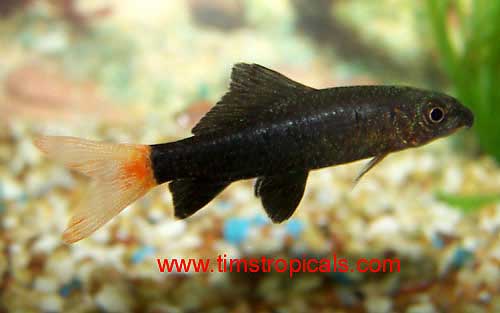 Red Tailed Black Shark
The Red Tailed Black Shark originally came from Thailand. The body is black with a distinctive
red tail. The black color can fade when the fish is distressed.
They are aggressive and intolerant of their own kind. Red Tails live at
the bottom of the tank and establish a territory among plants. Make sure
the tank is covered though, as they are jumpers. The other
community fish should be of similar or larger size and able to defend
themselves. If more than one Red Tailed Shark is kept in an aquarium,
hiding places are a necessity and a group of 3 or 4 Red Tails should be
maintained - this is not recommended. Breeding is extremely difficult due
to the intolerance of these fish for themselves.
Red Tailed Black Shark Profile
-
Scientific Name: Epalzeorhynchos bicolor
-
Family: Cyprinid
-
Temperature: 22 - 27 C; 72 - 80 F
-
pH: 7
-
Size: 12 cm; 5 inches
-
Life Span: 4 - 10 years
-
Breeding: Difficult, Egglayer
Red Tailed Black Shark Compatibility:
The Red Tailed Black Shark is compatible with Barbs, Bala Sharks, Danios, Gouramis,
Rainbowfish, Loaches, Plecos
Fred McFetters - I found out you can't keep Red Tailed Black Shark (RTS) and a Rainbow shark together, they fought like crazy until I put the rainbow in another tank. My fish tank with 5 bala sharks and the RTS is a happy place. The Red Tail lives in his rock cave, and makes his rounds a couple times a day where the bala sharks swim back and forth all day long.
Aquarium Shark Fish - Flying Fox
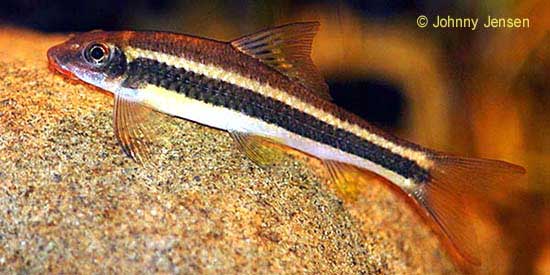
Flying Fox
The Flying Fox comes from the
Thailand, Sumatra and Borneo area. It is commonly confused with the Siamese Algae Eater
or Siamese Flying Fox (Crossocheilus siamensis), the Otto
and the Chinese Algae Eater (Gyrinocheilus
aymonieri). The Flying Fox is more colorful than the Siamese Algae
Eater. It has a black band running from its head to
its tail, but the band is much thicker and darker in the tail than that of a
Siamese Algae Eater. There is a golden stripe above the black horizontal
band, which cannot be found in the Siamese Algae Eater. For a discussion of the differences, see the
KRIB.
The Flying Fox can grow to 6 inches in the wild. The adult specimen is territorial and aggressive towards its own kind. Flying Foxes enjoy algae more when younger and do not have an appetite for red algae, which Siamese Algae Eaters do. They will eat common flake foods. There are no apparent sexual differences.
Flying Fox Profile
-
Scientific Name: Epalzeorhynchos kalopterus
-
Family: Cyprinid
-
Temperature: 24 - 26 C; 75 - 79 F
-
pH: 6.8
-
Size: 10 cm; 4 inches
-
Life Span: years
-
Breeding: Difficult, Egglayer
Flying Fox Compatibility:
The Flying Fox shark fish is compatible in a community
tank, but will defend their territory.
Only one adult is recommended in a tank. The flying foix is not compatible with the red tail black shark.
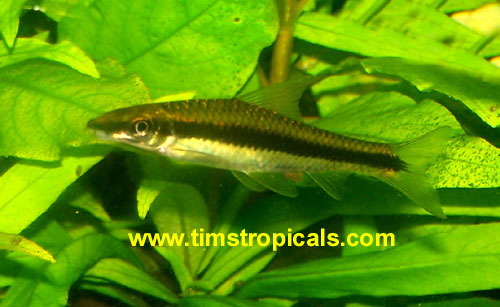 Siamese Algae Eater
The Siamese Algae Eater comes from fast flowing water in Thailand and Malaysia.
It is also known as the Siamese Flying Fox. It is commonly confused with the
Flying Fox, the Otto
and the Chinese Algae Eater (Gyrinocheilus
aymonieri). The Siamese Algae Eater or SAE has a distinctive black horizontal stripe
running from its head through its later line and into its tail fin. This band is
jagged along its edges. Below the horizontal band it is white and above
the band it is a gray/brown with each scale in this area having a dark
outline. The fins are transparent or can have hints of red. Another
distinctive feature are two small barbels on its nose. There are no apparent sexual differences.
SAEs should be provided lots of swimming space as they are very active.
A strong flow to the water will help to produce a more native habitat for
them. Siamese Algae Eaters will eat algae, including red algae, however their interest in
eating algae declines as they grow older. They will survive well on flake
foods. SAEs are not easily bred in captivity and most are imported from
Asia.
Siamese Algae Eater Profile
-
Scientific Name: Crossocheilus siamensis
-
Family: Cyprinid
-
Temperature: 24 - 26 C; 75 - 79 F
-
pH: 5.5 - 8.0
-
Size: 15 cm; 6 inches
-
Life Span: 10 years
-
Breeding: Difficult, Egglayer
Siamese Algae Eater Compatibility:
The Siamese Algae Eater is compatible in a community tank and can be kept in groups. SAEs will disturb slower moving fish such as gouramis and dwarf cichlids.
The Siamese Algae Eater is Not compatible with the red tail black shark.
Aquarium Shark Fish - Bala Shark
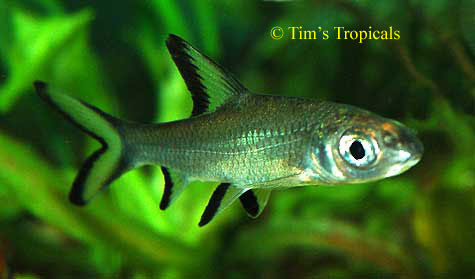
Bala Shark
The Bala Shark originally came from Southeast Asia around Indonesia. They are also known as the Tri Color Shark and they have a silver body with clear fins edged in black. Bala Sharks are a mild mannered and very active fish that need to be kept in numbers of at least 6. They look lovely in schools too. Because of their size and their need to school, an aquarium of more than 75 gallons should be used and it should have lots of open space. Bala Sharks eat flake foods, algae and just about anything you give them. These fish are extremely difficult to breed, as evidenced by a total lack of information on the subject.
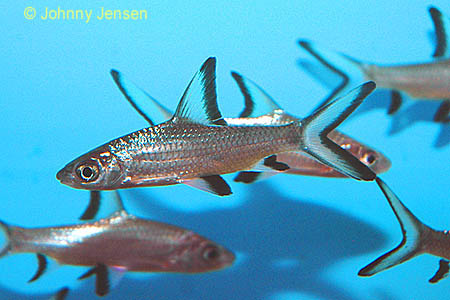
Bala Shark
Bala Shark Profile
-
Scientific Name: Balantiocheilos melanopterus
-
Family: Cyprinid
-
Temperature: 22 - 28 C; 72 - 82 F
-
pH: 6.8 - 7.2
-
Size: 17 cm; 7 inches
-
Life Span: 4 - 10 years
-
Breeding: Difficult, Egglayer
Bala Shark Compatibility:
The Bala Shark is compatible with Barbs, Danios, Gouramis, Rainbowfish, Loaches, Plecos, one Rainbow Shark, one Red Tailed Shark
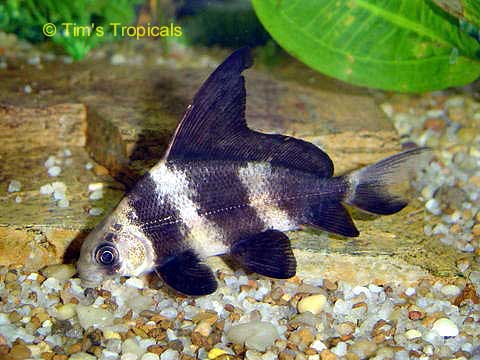
Chinese Hi Fin
Thanks
to Lemuel Martinez from Puerto Rico for the
following information:
The
Chinese Hi Fin is also called the Banded Hi Fin. It is mainly a herbivore as it has no
teeth. The Chinese Hi Fin will eat granules on the bottom. It is an endangered species in China
and most are wild caught. They told me the ones I bought were farm raised.
Anyway, as they grow they will loose the Hi Fin and will change its form and
color into a pleco like color and shape. But I have never read of
this happening in captivity. Because Hi Fins are so slow growing, one might never
see this happen. I actually have seen 8 inch ones and they still have the
high fin shape and color. Their behavior is super friendly. Chinese Hi Fins are very
active swimmers. In stores they might not look so nice, looking kind of pale, but when
they feel safe and have good water quality the bands turn completely black.
I have mine with Discus, Angels, Rainbows, tetras and a dwarf Gourami and no
problemo. The only fish that have attacked my high fins is my German Blue
Ram, but luckily there has been no damage.
Some other names for the Chinese Hi Fin are: Chinese High Fin, Chinese High
Fin Sucker, Sailfin Sucker, Topsail Sucker, Asian Sucker, Chinese Sucker, Wimple
Carp, Freshwater Batfish, Entsuyui.
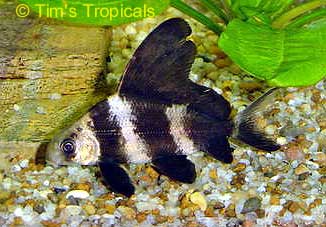
Chinese Hi Fin
Chinese Hi Fin Profile
-
Scientific Name: Myxocyprinus asiaticus
-
Family: Cyprinid
-
Temperature: 15 - 28 C; 59 - 82 F
-
pH: 6.5 - 7.5
-
Size: 60 cm; 24 inches
-
Life Span: years
-
Breeding: Difficult, Egglayer
Chinese Hi Fin Compatibility:
The Chinese Hi Fin is compatible with Angels, Discus, Dwarf Gouramis, Goldfish, Rainbowfish, Tetras
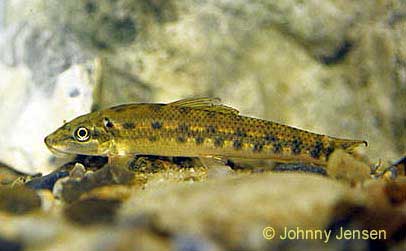
Chinese Algae Eater
The Chinese Algae Eater is misnamed, as it originated in Thailand. It
has an uneven horizontal stripe, transparent fins and a clinging sucker mouth,
which distinguishes it from the Flying Fox,
the Siamese Algae Eater and the
Otto. The CAE can intake water without opening its mouth. It
can grow to 10 inches but barely exceeds 5 inches in captivity. There is
also a golden variety which lacks the dark markings.
Chinese Algae Eater Profile
-
Scientific Name: Gyrinocheilus aymonieri
-
Family: Cyprinid
-
Temperature: 22 - 28 C; 72 - 82 F
-
pH: 7
-
Size: 10 cm; 4 inches
-
Life Span: 5 years
-
Breeding: Difficult, Egglayer
Chinese Algae Eater Compatibility:
The Chinese Algae Eater is compatible in a community tank, though they may get more aggressive with age and may attack slow moving, flat bodied fish.
Although they look great when they are young, Iridescent Sharks grow too big for a regular aquarium. In Asia they are caught in sport fishing.
The Iridescent Shark comes from China. They are known by the scientific
name Pangasius hypophthalmus and Pangasius sutchi. They are best kept in schools and they need open spaces for moving rapidly.
The Iridescent Shark is actually a catfish and is also referred to as the Sutchi Catfish.
Comments by LittleHippyGirl:
Iridescent sharks make very poor aquarium inhabitants. I'm assuming that the huge difference in size
is because of stunting, similar to goldfish. If you stick a goldfish in a 5 gallon tank, it will probably
grow to around 4-5". If you give it an understocked 40 gallon or pond, it has the potential to reach 10-16",
depending on the breed. Fish excrete a growth inhibiting hormone into the water, and the higher the concentration,
the less growing they will do. This may seem convenient to some people, but it is very unhealthy to the fish, and
its life span is usually drastically reduced. A little stunting usually doesn't do too much harm, but stunting a 48" fish down to 12" is definitely harmful to the fish.
Iridescent Shark Profile
-
Scientific Name: Pangasius hypophthalmus
-
Family: Cyprinid
-
Temperature: 22 - 26 C; 72 - 79 F
-
pH: 6.5 - 7.5
-
Size: 125 cm; 50 inches
-
Life Span: ?
-
Breeding: Difficult, Egglayer
Iridescent Shark Compatibility:
The iridescent shark grows too large for regular aquarium life.
|









